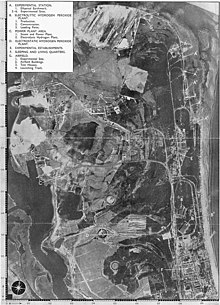| Operation Hydra | |||||||
|---|---|---|---|---|---|---|---|
| Part of Operation Crossbow | |||||||
 British plan for the Peenemünde raid | |||||||
| |||||||
| Belligerents | |||||||
|
(5, 6, 8 groups) RAF Fighter Command |
| ||||||
| Commanders and leaders | |||||||
| John Searby (Master Bomber) |
Josef Kammhuber Hubert Weise | ||||||
| Strength | |||||||
|
Hydra: 596 aircraft dispatched, 560 bombed 324 Avro Lancaster, 218 Handley Page Halifax, 54 Short Stirling 1,924 long tons (1,955 t) bombs (1,795 long tons (1,824 t) dropped), 85 per cent HE Whitebait: 8 Mosquitos Intruders: 28 Mosquitos, 10 Beaufighters | Hydra: 35 night fighters inc. 2 Bf 109 c. 30 Focke-Wulf Fw 190 | ||||||
| Casualties and losses | |||||||
|
290: 245 killed, 45 POW Hydra: 23 Lancasters, 15 Halifaxes, 2 Stirlings |
12 aircrew killed, 12 aircraft lost: 8 Bf 110, 1 Do 217, 2 Fw 190, 1 Bf 109 c. 180 Germans, 500–732 slave workers 3 men and 1 convict labourer (by a bomb on Berlin)[2] | ||||||
Operation Hydra was an attack by RAF Bomber Command on a German scientific research centre at Peenemünde on the night of 17/18 August 1943. Group Captain John Searby, commanding officer of No. 83 Squadron RAF, commanded the operation, the first time that Bomber Command used a master bomber to direct the attack of the main force.
Hydra was the first operation against the German V-weapon programme, a campaign later known as "Crossbow".[3] The British lost 40 bombers and 215 aircrew, and several hundred enslaved workers in the nearby Trassenheide forced labour camp were killed. The Luftwaffe lost twelve night-fighters and about 170 German civilian personnel were killed, including two V-2 rocket scientists.
Assessments of the raids effectiveness vary; the United States Strategic Bombing Survey (1945) called the raid "not effective", while in 2006 the historian Adam Tooze judged that it had been highly successful.
- ^ Middlebrook 2006, p. 3.
- ^ Irving 1964, p. 102.
- ^ Neufeld 1995, p. 198.